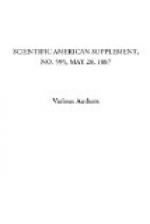Directions for use.—Partially fill the pan with water and allow it to boil. Place a given quantity of flour in the inner vessel, D, taking care first to weigh it. Subject it to the action of the boiling water until it is perfectly dry, which will be indicated by the steam ceasing to issue from the funnels. Then weigh again, and the difference in the weight will represent the quantity of moisture contained in it, dried at a temperature of 212 degrees Fahr., that of boiling water.—The Miller.
* * * * *
APPARATUS FOR MANUFACTURING BOUQUETS.
For some years past, the sale of flowers has been gradually increasing. Into the larger cities, such as Paris for example, they are introduced by the car load, and along about the first of January the consumption of them is extraordinary. All choice flowers are now being cultivated by improved methods that assure of an abundant production of them. What twenty years ago would have appeared to be an antiquated mechanism, viz., an apparatus for making bouquets, has now become a device of prime necessity by reason of the exigencies of an excessive demand.
Mr. Myard, a gardener of Chalon-sur-Saone, and vice-president of the horticultural society of that city, has devised a curious apparatus, which we represent herewith from a photograph.
This bouquet machine, which the inventor styles a bouquetiere, consists of a stationary rod (shown to the right of the figure), upon which slides a spool wound with twine, and the lower part of which is provided with three springs for keeping the twine taut. A horizontal arm at the top supports a guide or pattern whose curve is to be followed, on placing the flowers in position. This arm is removed or turned aside after the binding screw has been loosened, in order that the rod to the left that carries the bouquet may be taken out. A guide, formed of a steel ribbon, is fixed to the arm and to its movable rod by means of binding screws, which permit of its being readily elongated. This central rod can be raised or lowered at will, and, owing to these combinations, every desired form of bouquet may be obtained.
[Illustration: APPARATUS FOR MAKING BOUQUETS.]
The rod to the left is provided with a steel pivot, and contains several apertures, into which a pin enters, thus rendering it easy to begin bouquets at different heights.
The bouquet is mounted upon the rod to the left, as shown in the figure. The pin passes through the rod and enters a loop formed at the extremity of the twine, and thus serves as a point of support, and prevents the bouquet from falling, no matter what its weight is. When the pin is removed in order that the bouquet may be taken out, the loop escapes.
At the lower part of the rod upon which the bouquet is mounted, there is a collar with three branches, by means of which a rotary motion is given to the flowers through the aid of the hand. The twine used for tying is thus wound around the stems. When the apparatus is in motion, the twine unwinds from the spool, and winds around the rod that carries the flowers, and twists about and holds every stem.




